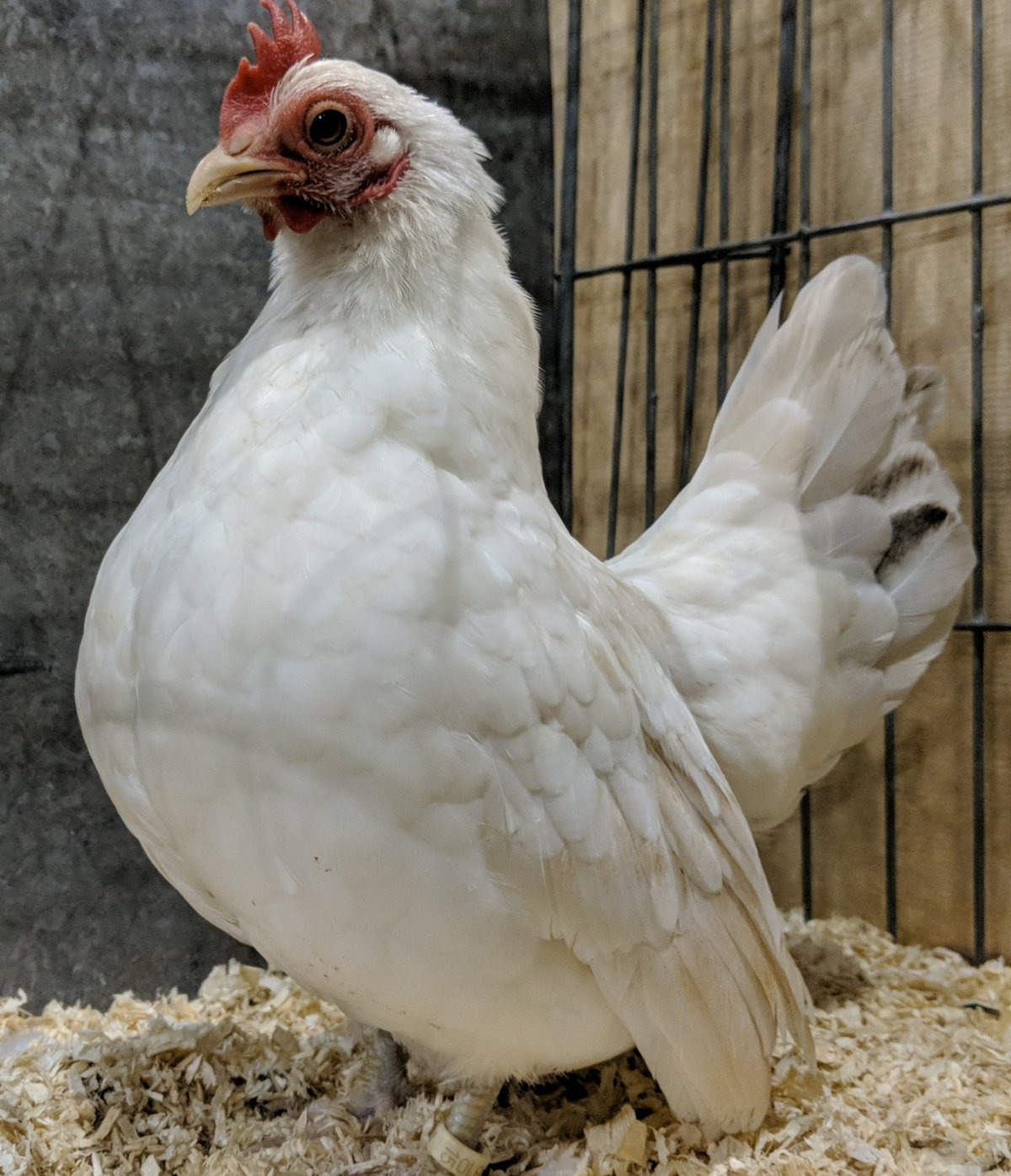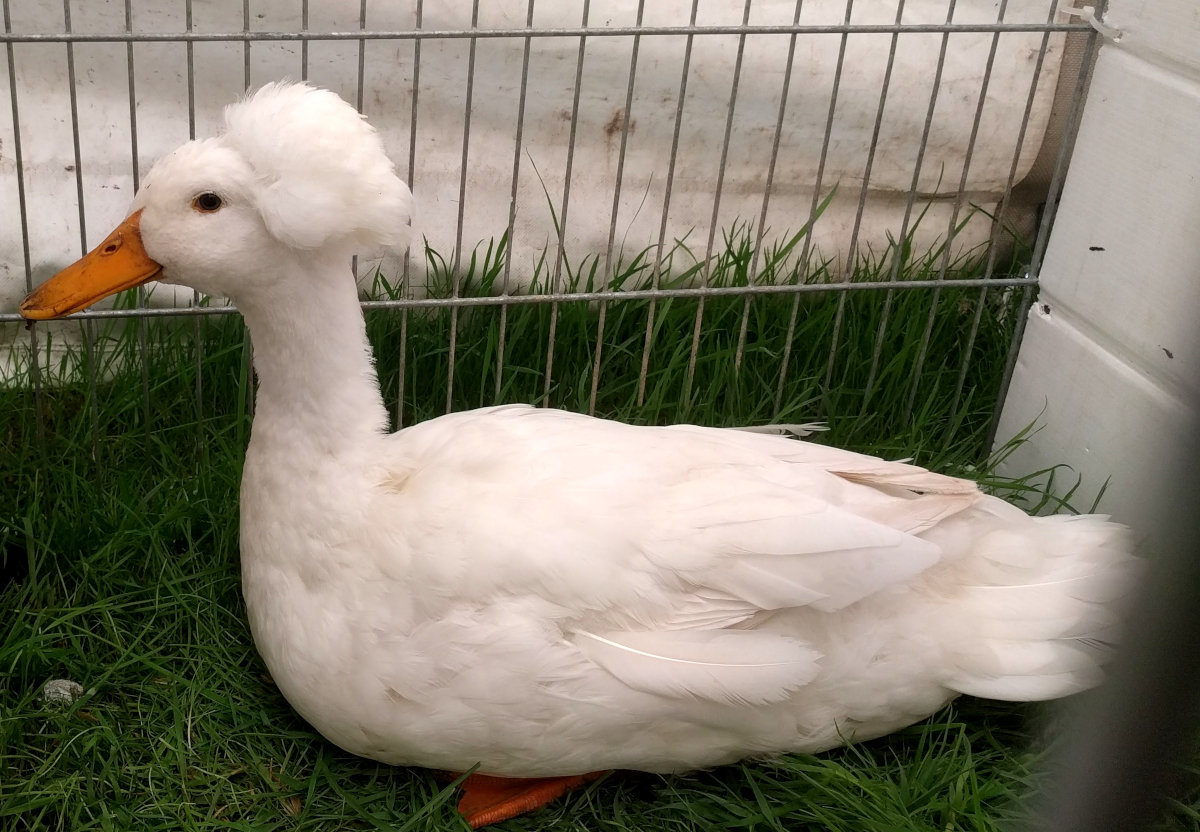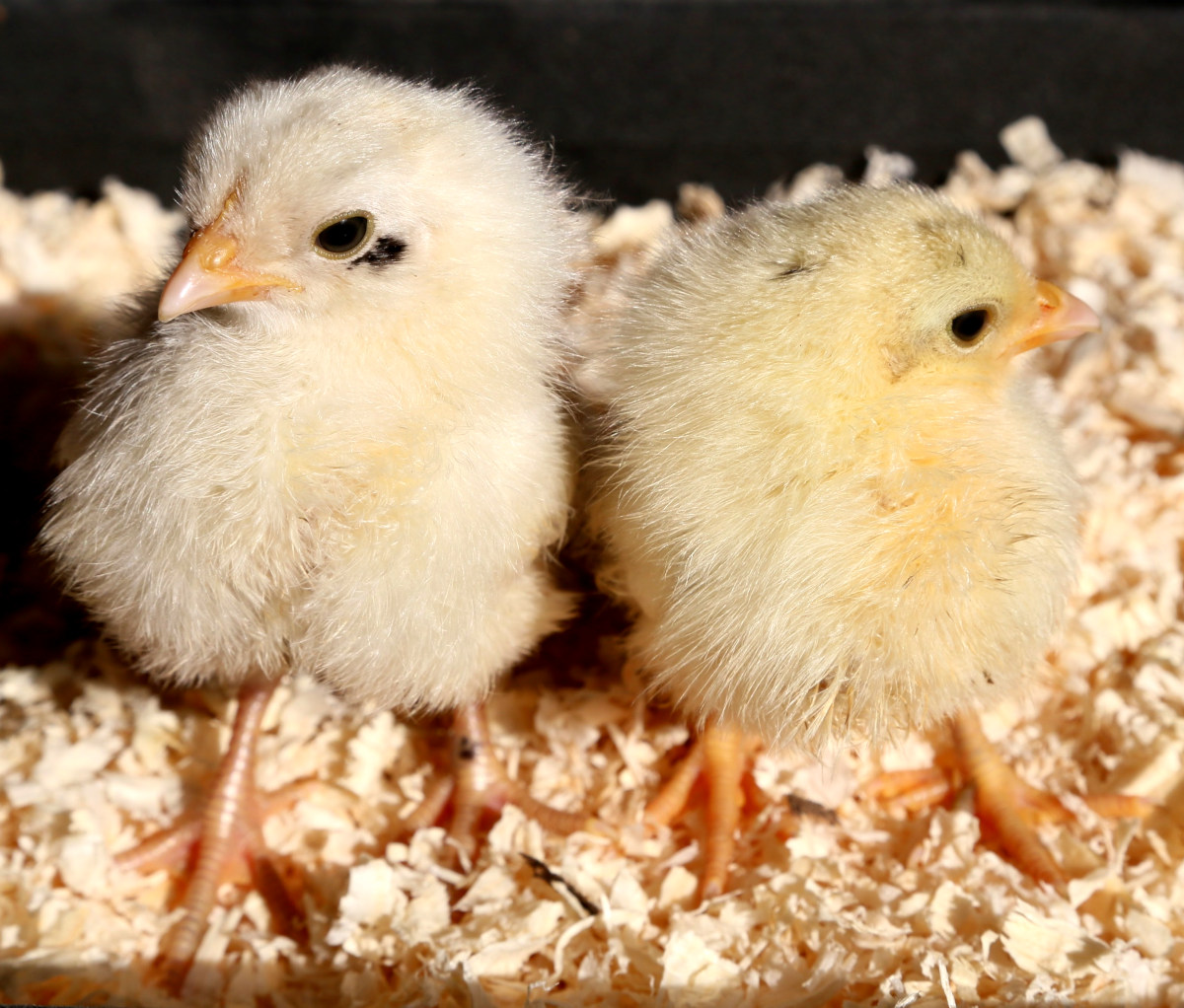Lethal genes in chickens and poultry and what to do if you have them in your flock.

It's important to note that lethal alleles are relatively rare in the population because they tend to be eliminated through natural selection over time.
Table of Contents
Human interference in the breeding process has allowed these mutations to survive in the population.
What causes lethal genes?
Lethal genes, also known as lethal alleles, are genetic variants or mutations that can cause the death of an organism when present in a homozygous condition (when two identical copies of the gene are inherited).
Below: The crest on this duck is the result of a lethal gene. One copy gives you the crest and two copies of the gene is always fatal before hatching.

Lethal genes are genetic mutations that cause an embryo or fetus to die before birth, or shortly after birth. They can be caused by a number of factors, including:
- Errors in DNA replication: During DNA replication, the process of copying DNA from one cell to another, errors can occur. These errors can lead to genetic mutations, including lethal genes.
- Environmental factors: Environmental factors, such as exposure to radiation or certain chemicals, can also cause DNA damage and lead to genetic mutations.
- Inheritance: Lethal genes can also be inherited from parents. If a parent has a lethal gene, there is a 50% chance that their child will inherit it.
Lethal genes can be classified into two main types:
- Dominant lethal genes: Dominant lethal genes require only one copy of the gene to cause death. If offspring inherits a dominant lethal gene from one parent, they will die, even if they inherit a normal copy of the gene from the other parent.
- Recessive lethal genes: Recessive lethal genes require two copies of the gene to cause death. If the offspring inherits one copy of a recessive lethal gene from each parent, they will die. If they inherit only one copy of the gene, they will be a carrier of the gene, but they will not be affected.
This means that if an organism inherits two copies of the same lethal allele, it will not survive to birth or will die shortly after birth. There is no cure or treatment for lethal genes.
Examples of lethal genes in chickens:
I bred Japanese bantams for a while as I liked having them around. The selection is critical to make sure you don't breed two short legged birds together. I used to base my selection on the sex of the bird and always chose normal legged males and short legged hens for the breeding pen.
The creeper gene in Japanese bantams and the ear tuft gene in the Araucana are examples where 2 copies of the gene are fatal but 1 copy has an effect on the offspring for that genes trait.
Below: The creeper gene in action on my Japanese bantam chicks. The chick on the left has normal legs and the chick on the right has one copy of the creeper gene.

Lethal genes are those that can kill in poultry. Some genes are lethal when both alleles are present. Lethality can occur before or after hatching
Common genetic factors that don't qualify as lethal genes, but that do reduce hatch-ability, are frizzled and rumpless and large crests in Polish.
The (Lav) lavender gene is associated with poor feather quality and the Rosecomb (RR) gene can be associated with low fertility. These are not technically lethal even though they result in increased mortality.
Another example is the Crested duck. C is crested and non-crested are c:
- If you breed two non-crested ducks (cc x cc) then all the offspring are cc and have no crest.
- If you breed a crested (Cc) and non-crested (cc) duck 50% of the young will be crested (Cc) and 50% no crest.
- If you breed two crested birds (Cc x Cc) 25% of the young will be no crest, (cc), 50% will be crested (Cc or cC) and a quarter will have two crested genes (CC) and as such will be crested but never hatch. This is a lethal gene if two copies are present.
The presence of lethal genes means your hatch rate is automatically reduced by 25% before you even start to breed.
What are lethal the genes in chickens?
As a result of years of study on the genetic structure of chickens, we know of more than 100 loci that are lethal, most were autosomal and the others were sex-related characters.
Below: A chick with a scissor or cross beak.

If you are breeding chickens, it is important to be aware of the potential for lethal genes. You can do this by researching the breeds you are breeding and by testing your breeding stock for known lethal genes.
Here is a table of the known lethal genes in chickens with a little about each one:
| Gene or allele | Lethal effect |
|---|---|
| Creeper | Creeping genes in chickens giving rise to short legs. Found in birds such as in Scots Dumpy, Serama or Japanese bantams. Creeper is a dominant gene, heteroyzous chickens display the creeper phenotype |
| Donald duck. | In the Barnevelder, and some other breeds, the lethal gene causes "Donald Duck syndrome", in which the upper beak curls upward, the lower beak curls downward, and death occurs in the last days of incubation. I have bred Barnevelders for many years and never seen this one. |
| Ear-tuft (Et) gene | The ear-tuft (Et) gene is autosomal dominant. Mortality varies on whether they are hetero or homozygous. Mortality is as high as 41.6 percent with most dying before hatch and few during the week after hatching. |
Cross Beak Gene (Cr/Cr) | Chickens with the cross beak gene (Cr/Cr) can have misaligned beaks, which can make it challenging for them to eat and drink. Severe cases may require special care or culling. |
| New Hampshire reds carry a lethal that causes death in the twentieth and twenty-first day of hatch. Signs are crooked necks, short upper beaks, and shrivelled leg muscles. | |
| Blood ring. | Blood ring describes a lethal embryonic condition in chickens that is expressed between 48 and 66 h of incubation and effects around 0.15% of eggs. |
| Polydactyly Gene (Po/Po) | Chickens with the polydactyly gene (Po/Po) can have extra toes. While this trait is usually harmless, severe cases can lead to foot deformities, affecting the bird's ability to walk. |
| Cornish lethal | Dark Cornish carry a similar short-leg gene that causes death at the time of hatch. Signs of "Cornish lethal" include short beaks and wings, and bulging eyes. |
| Congenital tremor | Congenital tremor is a lethal gene found in some breeds including Ancona, Plymouth Rock, Rhode Island Red, white Leghorn, and white Wyandotte. Chicks hatch but can't control their neck muscles. When a chick tries to stand, its head falls over and the bird falls down. Unable to eat or drink, it dies soon after hatching. |
| Stunting | The silver Gray Dorking has a lethal gene that causes death in the ninth day of incubation. Embryos have short necks and beaks. |
Naked neck. (Na/na) | This gene causes the chicken to lack feathers on its neck. Chicks that inherit two copies of the gene die in the shell before hatching. While this trait can be beneficial in hot climates, it may make them more susceptible to cold temperatures. |
Frizzle (Ff) | This gene causes the chicken's feathers to curl. Chicks that inherit two copies of the gene tend to die shortly after hatching or live poor and short lives due to respiratory and feather problems. The frizzle gene is lethal in some breeds of chickens, but only causes mild feather curling in other breeds. |
| Dwarfism | Different from the two genes in bantam chickens, this gene causes the chicken to be much smaller than normal. Chicks that inherit two copies of the gene die in the shell before hatching. |
| Lethal white | This gene causes the chicken to be completely white. Chicks that inherit two copies of the gene die soon after hatching due to blood cell problems. |
Osteopetrosis (Os/Os) | Chickens with two copies of the osteopetrosis gene (Os/Os) have excessively thickened bones, which can lead to skeletal deformities and mobility issues. This condition is usually lethal, and affected birds often don't survive long. |
| Syndactyly | This gene causes the chicken's toes to be fused together. Chicks that inherit two copies of the gene die soon after hatching due to respiratory problems. |
| Black Minorca - short legs with extra toes. | |
| Rhode Island Red - short legs, wings, and beaks. | |
| White Wyandotte - early embryonic death. | |
| My Serama bantams have inherited the creeper gene from their Japanese ancestors. | |
| Parrot beak | Short legs and parrot-like beaks. |
This is not an exhaustive list of all known lethal genes in chickens. New genes are being identified all the time.
Additionally, the effects of these genes can vary depending on the breed of chicken. For example, the frizzle gene is lethal in some breeds of chickens, but only causes mild feather curling in other breeds.
How to deal with lethal genes in your flock:
Lethal genes can lead to the birth of offspring with severe genetic disorders or even death and the alleviation of pain and suffering would be a prime concern for me.
I don't have a one-size-fits-all answer to this question, as the best course of action will vary depending on the specific circumstances. For example, if you have a small flock and only a few animals are affected by lethal genes, you may be able to simply remove them from the breeding pool.
However, if you have a large flock and many animals are affected, you may need to take more drastic measures.
For well known lethal genes like the creeper gene in Japanese bantams I have simply structured my breeding program to make sure that two short legged birds are not ever mated together.
These are some of the measures I have taken to remove lethal and unwanted genes from my flock:
- Identifying and removing affected animals from the breeding pool: Monitor your flock for signs of health problems associated with these lethal genes.
- Genetic Testing: First, confirm the presence of lethal genes in your flock through genetic testing. This may involve DNA analysis or other diagnostic methods to identify carriers of the lethal genes.
- Document and Track: Keep thorough records of all genetic testing results, pedigrees, and breeding histories of your animals. This documentation will help you make informed breeding decisions.
- Selective Breeding: Avoid breeding individuals that carry the lethal genes together. Lethal genes are usually recessive, meaning they only show their effects when present in pairs (homozygous). By selectively breeding carriers of lethal genes to animals that do not carry those genes, you can reduce the risk of producing offspring with lethal genetic disorders.
- Culling: In some cases, it may be necessary to cull animals that carry two copies of the lethal gene (homozygous carriers) or those with severe genetic disorders. This step is often taken to prevent further propagation of these genes in the flock and to maintain the overall health and quality of your breeding population.
- Introduce New Genetics: If the prevalence of lethal genes in your flock is high, consider introducing new animals from unrelated or genetically diverse sources to dilute the presence of these genes in your breeding population.
- Consult with Experts: Seek advice from veterinarians, geneticists, or breed-specific experts who can provide guidance on managing lethal genes in your flock. They can help you develop a strategic breeding plan to minimize the risk of producing affected offspring.
- Educate Yourself: Continuously educate yourself about genetics and breeding practices. Understanding the inheritance patterns of lethal genes and how to manage them is crucial for responsible flock management.
- Long-Term Breeding Goals: Consider your long-term breeding goals and objectives. You may need to make tough decisions about which traits are most important to your breeding program and whether you're willing to sacrifice certain traits to eliminate lethal genes.
- Ethical Considerations: Always prioritize the welfare of your animals. Balancing genetic improvement with ethical treatment and humane care is essential in any breeding program.
- Keep Records and Monitor Progress: Regularly update your records and monitor the progress of your breeding program. Over time, you should see a reduction in the prevalence of lethal genes in your flock if you are implementing responsible breeding practices.
